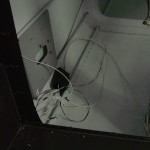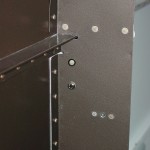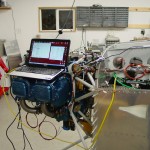APRS Tracker
Hours: 2.5 | Posted in ElectricalMy APRS transmitter from Byonics arrived today (along with an oil cooler and spark plugs from Spruce), so I thought that would be a simple and satisfying installation. First, I opened up the tracker and wired a short piece of 22-3 to the internal LED, bringing it out through a small hole in the case. A 3-pin Molex went on the end–this is to drive a bicolor LED like the one built into the tracker, but external, since I will have the tracker mounted behind the baggage bulkhead. Having installed a TinyTrak in my car, I know it’s handy to have the status lights to see what the tracker is doing. With the external LED plug wired, I closed the case back up and proceeded with the installation on the plane.
I put a pair of small holes in the baggage bulkhead, far enough to the side that they won’t interfere with the corrugated wall panel. The top hole received the bicolor LED; it indicates green for GPS status (flashing means it’s receiving data, solid indicates a valid fix), and red to indicate it is transmitting a position packet. The lower hole is occupied by a 3.5mm TRS jack, similar to the ones I’ve used in several other places for RS-232 service ports. This one is a bit different, since the other (Pmags and ADS-B) are dedicated serial ports on the devices, whereas the tracker also receives its GPS signal via this port. So, a normalling jack is used here — when there is no plug inserted, the GPS signal is fed to the tracker. Inserting a plug breaks the GPS connection, and connects the tracker’s input and output to the computer.
I could have put the LED on the panel, but a) it’s not at all a critical item, b) the flashing light could be distracting, especially at night, c) that would require another wire through the spar, and d) it’s still readily visible by looking over my shoulder. Both the LED and the port are easily accessible for servicing the tracker and checking it’s operation, while being completely out of the way.
Wired the tracker to power, too, and enabled that pin on the VP-X. Terminated the coax from the NMO mount with an SMA connector, hooked that up and flipped the switch. The tracker booted right up, so I powered the GPS and got a solid green light. Good to go. The service port is functional, and I programmed the tracker config and grabbed my handheld scanner to verify that it is transmitting. None of the packets hit the internet, which doesn’t surprise me at all since it’s on the bottom of the fuselage (which makes sense in the air), and inside the shop.



